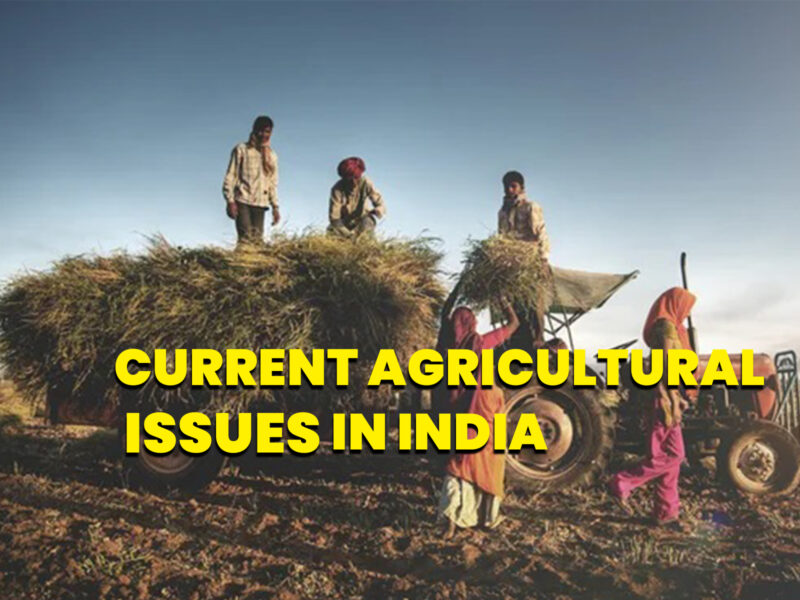introduction
Here we will discussed about the current agricultural issues in India. The importance of the sector in India’s economic and social fabric goes far beyond this metric, even though agriculture’s part of the country’s economy has gradually decreased to less than 15% as a result of the strong growth rates of the industrial and services sectors.
Small and Fragmented Land-holdings
Since India’s independence, land ownership has been fragmented. With each new generation, the amount of the arable plot gets smaller, mostly because of inheritance regulations. The property that a parent owns is divided up and inherited by his or her wards.
The number of farms has doubled from 70 million in 1970 to 145 million in 2015 and counting since the first agriculture census 45 years ago.
In addition to difficulties with farming, the farmer must also deal with challenges off the farm. One of them is litigation brought about by fragmentation, a sort of property conflict that is fairly typical. Land conflicts are at the heart of about 25% of all Supreme Court decisions. Again, land conflicts are at the center of 66% of all civil proceedings in India. current agricultural issues in India.
Fertilisers and Manures
current agricultural issues On Indian soils, crops have been produced for tens of thousands of years without any thought to replenishment.
Due to this, soils have become depleted and tired, which has reduced their productivity.
Around 70% of the increase in agricultural output, according to estimates, can be attributed to increased fertiliser application. Thus, a rise in fertiliser use is a sign of agricultural prosperity.
It is difficult to supply adequate manures and fertilizers throughout a nation the size of India, which is home to many low-income peasants.
Chemical fertilizers are costly and frequently out of small-scale farmers’ price ranges. As a result, the fertiliser problem is complicated and serious.
On Indian soils, crops have been produced for tens of thousands of years without any thought to replenishment. Nearly all crops have some of the lowest average yields in the entire planet. More manures and fertilizers can be used to address this major issue.
Lack of Mechanisation
Despite the extensive mechanization of agriculture in some regions of the nation, the majority of agricultural operations are still conducted by hand in the majority of those regions, employing straightforward and customary equipment and implements like wooden ploughs, sickles, etc.
Little to no machinery is needed for plowing, sowing, irrigating, thinning and pruning, weeding, harvesting, threshing, and transporting crops. This is true, especially for small and marginal farms. As a result, a lot of human labor is wasted, and worker productivity is low.
If we help them, the number of young people employed in farming and related industries would rise. Since they already have a foundational institutional education and competence, they can learn and grow quickly.
Current agricultural issues in Irrigation
Only one-third of India’s cropland is irrigated, despite the fact that it is the world’s second-largest irrigated nation after China. In a country with a tropical monsoon like India, where rainfall is unpredictable, unreliable, and variable, irrigation is the most crucial agricultural input.
India is the world’s second-largest irrigated nation after China, but just one-third of its crops is irrigated. India won’t be able to make significant agricultural advancements unless and until more than 50 per cent of the planted area is covered by reliable irrigation.
For broad tracts, irrigation is still necessary to boost agricultural yield.
Water resources can be utilised to their fullest extent and conveniently dispersed to the locations where they are most required through interstate cooperation on water management.
Inadequate storage facilities
Agri-warehousing capacity in India is currently around 91 MMT, with governmental agencies owning 41% of the capacity and the other 59% being shared by private business owners, cooperative groups, farmers, etc.
Although hired capacity of 23 MMT is included in India’s overall agro storage capacity, these government entities use 66% (60 MMT) of it.
The storage capacity offered by government agencies is primarily used to maintain a central stock of food grains for the buffer stock, public distribution systems, and other government schemes.
India is the world’s second-largest irrigated nation after China, but just one-third of its crops is irrigated.
Capital
Agriculture is a sizable industry, and like other industries, it depends on funding to function. The significance of capital input is increasing as agricultural technology advances. Because his capital is vested in his fields and stocks, the agriculturalist needs borrow money to speed up agricultural output.
Even so, the lender continues to be the only provider of agricultural loans while losing ground. Institutions like Central Cooperative Banks, State Cooperative Banks, Commercial Banks, Cooperative Credit Agencies. and even Government Agencies must offer farmers loans with favorable terms in order to dramatically alter the rural financial environment.
Agricultural Marketing
In rural India, agricultural marketing is still in poor shape. Farmers must rely on local traders and middlemen to dispose of their farm products, which are sold at a loss because there are no reliable marketing facilities.
Most of the time, these farmers must continue selling their produce at a loss due to their socioeconomic situation.
In the absence of a formalized marketing structure, trading companies and middlemen prevail in the advertising and trade of agricultural products.
The cost of the middlemen’s services is increased by their pay, but the farmers do not benefit in a manner that is equal.
To free the farmer from the control of financial middlemen and money lenders, the government has established regulated markets.
Inadequate transport:
Lack of affordable and effective transportation is one of India’s major agricultural disadvantages. Even now, there are thousands of towns that are poorly connected to either market centers or important roads.
When examining the movement of agricultural products! it becomes clear that transportation expenses play a crucial part in understanding the connection between accessibility and agricultural development. A reliable transportation system is essential for effective agricultural marketing.
Since it is the primary method of moving agricultural goods from farms to markets and other urban areas, road transportation is essential for the distribution of agricultural goods.
Conclusion:
The knowledge and infrastructure gaps, especially in rural regions, are the current major problems affecting Indian agriculture. Infrastructure issues with regard to markets, transportation, and irrigation add significant costs to farmers’ operations. The absence of delivery mechanisms is another problem. Several programs exist with the goal of developing agriculture.
Furthermore, little government support makes these problems worse. Corporate farming may therefore be a solution for the Indian agrarian sector
but it requires careful consideration, innovation, and better rules to ensure that neither the corporates nor the farmers suffer.
Priority should be given to serving the needs of small farmers, who are most at risk from the monsoons; more people should also have access to services like financing and crop insurance.




